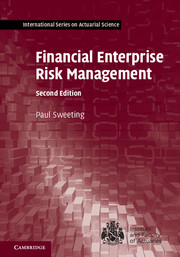Book contents
- Frontmatter
- Contents
- Preface
- 1 An Introduction to Enterprise Risk Management
- 2 Types of Financial Institution
- 3 Stakeholders
- 4 The Internal Environment
- 5 The External Environment
- 6 Process Overview
- 7 Definitions of Risk
- 8 Risk Identification
- 9 Some Useful Statistics
- 10 Statistical Distributions
- 11 Modelling Techniques
- 12 Extreme Value Theory
- 13 Modelling Time Series
- 14 Quantifying Particular Risks
- 15 Risk Assessment
- 16 Responses to Risk
- 17 Continuous Considerations
- 18 Economic Capital
- 19 Risk Frameworks
- 20 Case Studies
- 21 Solutions to Questions
- References
- Index
1 - An Introduction to Enterprise Risk Management
Published online by Cambridge University Press: 12 August 2017
- Frontmatter
- Contents
- Preface
- 1 An Introduction to Enterprise Risk Management
- 2 Types of Financial Institution
- 3 Stakeholders
- 4 The Internal Environment
- 5 The External Environment
- 6 Process Overview
- 7 Definitions of Risk
- 8 Risk Identification
- 9 Some Useful Statistics
- 10 Statistical Distributions
- 11 Modelling Techniques
- 12 Extreme Value Theory
- 13 Modelling Time Series
- 14 Quantifying Particular Risks
- 15 Risk Assessment
- 16 Responses to Risk
- 17 Continuous Considerations
- 18 Economic Capital
- 19 Risk Frameworks
- 20 Case Studies
- 21 Solutions to Questions
- References
- Index
Summary
Definitions and Concepts of Risk
The word ‘risk’ has a number of meanings, and it is important to avoid ambiguity when risk is referred to. One concept of risk is uncertainty over the range of possible outcomes. However, in many cases uncertainty is a rather crude measure of risk, and it is important to distinguish between upside and downside risks.
Risk can also mean the quantifiable probability associated with a particular outcome or range of outcomes; conversely, it can refer to the unquantifiable possibility of gains or losses associated with different future events, or even just the possibility of adverse outcomes.
Rather than the probability of a particular outcome, it can also refer to the likely severity of a loss, given that a loss occurs. When multiplied, the probability and the severity give the expected value of a loss.
A similar meaning of risk is exposure to loss, in effect the maximum loss that could be suffered. This could be regarded as the maximum possible severity, although the two are not necessarily equal. For example, in buildings insurance, the exposure is the cost of clearing the site of a destroyed house and building a replacement; however, the severity might be equivalent only to the cost of repairing the roof.
Risk can also refer to the problems and opportunities that arise as a result of an outcome not being as expected. In this case, it is the event itself rather than the likelihood of the event that is the subject of the discussion. Similarly, risk can refer to the negative impact of an adverse event.
Risks can also be divided into whether or not they depend on future uncertain events, on past events that have yet to be assessed or on past events that have already been assessed. There is even the risk that another risk has not yet been identified.
When dealing with risks it is important to consider the time horizon over which they occur, in terms of the period during which an organisation is exposed to a particular risk, or the way in which a risk is likely to change over time. The link between one risk and others is also important. In particular, it is crucial to recognise the extent to which any risk involves a concentration with or can act as a diversifier to other risks.
- Type
- Chapter
- Information
- Financial Enterprise Risk Management , pp. 1 - 10Publisher: Cambridge University PressPrint publication year: 2017
- 1
- Cited by



